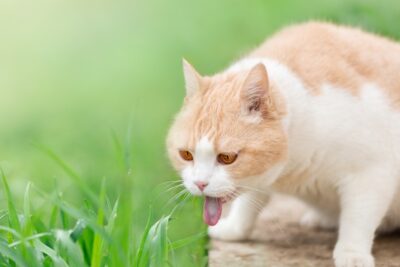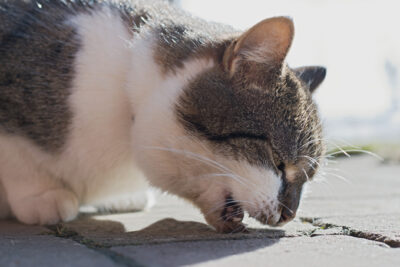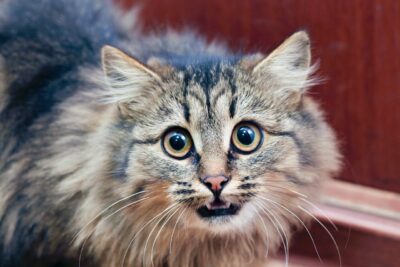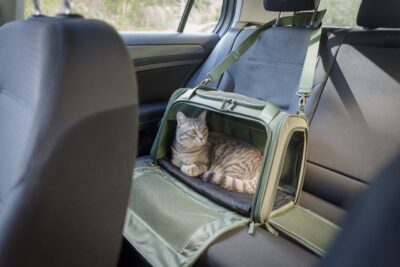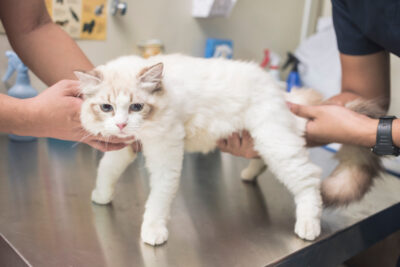Incontinence in Cats

When a cat urinates a little bit outside of the litter box, pet parents sometimes tend to feel a bit angry. Cat urine is stinky, and no one wants to spend extra time cleaning up the mess! Most cats can sense the need to urinate and choose to urinate outside the box for one reason or another.
Even more troubling is when your cat doesn’t even know that they’ve urinated. This is called urinary incontinence in cats. If your cat is urinating outside of the litter box, how will your veterinarian determine if your cat is incontinent? How does it differ from cats who know they are urinating? Read on for an overview, including symptoms, causes, and treatments.
What Is Incontinence?
Urinary incontinence is when urine leaks from the bladder, and a cat is unaware that it has happened. Incontinence in cats is rare. Only 4 percent of cats with urinary issues are incontinent, but it can occur at any age.
Urine leakage while your cat is sleeping or resting is common. If your cat is excited or extra stimulated from something like active play, leakage may occur then, too. Cats with urinary problems that are not incontinent choose where they urinate, including outside of the litter box. When this occurs, you may catch your cat squatting in the usual position for urination or standing with their tail straight up, spraying urine directly behind them.
Incontinence Symptoms in Cats
Determining if your cat is incontinent versus choosing to urinate outside the litter box can be difficult. Incontinent cats have variable symptoms. They may urinate a small or large amount, dribble (i.e. drip) or not dribble urine, and be incontinent sometimes while continent other times. If you feel like your cat is leaking urine, is always wet around the butt and genitalia, or has urine scalding (skin irritation from urine in that area), they are more likely to be incontinent. Also, incontinent cats tend to urinate smaller amounts than the average cat.
Possible symptoms of incontinence in cats include:
- Fecal incontinence (i.e. cannot control pooping)
- Stumbling or walking drunk
- Weakness when trying to stand or move around
- Increased drinking
- Tail cannot move and hangs limply down
- Redness and moisture to skin around butt and genital area
Urinary signs include:
- Straining to urinate
- Dribbling urine
- Urinating small amounts
- Bloody (red-tinged) urine
- Vocalizing in the litter box
- Urinating outside the litter box
- Licking genitalia frequently
- Urinating while sleeping or lying down to rest
Causes of Feline Incontinence
There are many possible causes of incontinence in cats. 40 percent of cats will have issues with the spinal cord. Following closely are problems with the urethra, the tube leading urine out of the body from the bladder. Other problems with the bladder or problems with anatomy make up the remaining causes.
Cat incontinence causes may include:
Problems with the spine
- Inflammation of the lumbar vertebrae (lower back bones of the spine) keep urethra from staying closed
- Trauma
- Intervertebral disk disease (soft disks that cushion between each bone of the spine can become inflamed and pinch the spine)
- Cancer
- Spinal stroke, i.e. embolism
Problems with the urethra
- Weak muscle in the urethra. A weak muscle cannot keep the urethra closed, leading to urine leakage.
- Urethral sphincter incompetence (urethra cannot stay closed for reasons other than muscle). One cause is a congenital condition, meaning a cat was born with the issue due to genetics
- Inflammation or cancer of the urethra
- Urinary tract infections (temporary incontinence)
- Partial blockage
Problems with the bladder
- Overactive muscle (constantly squeezing the bladder)
- Inflammation of the bladder (temporary incontinence)
- Cancer of the bladder
- Bladder infection or stones
- Cerebellar disease (inflammation in the tail-end of the brain that controls movement and balance)
- Bladder muscle instability due to feline leukemia virus infection
- Bladder atony (muscle is stretched and non-responsive after being unusually full)
Problems with anatomy
- Ectopic ureters (tubes from kidneys that lead to the bladder connect to the bladder at abnormal places)
- Underdeveloped urethra
- Malformations of the spine
Diagnosing Cats with Incontinence

Urinary incontinence is diagnosed by physical examination and extensive history from pet parents. A history of recent trauma would hint to the issue, but most of the time, questions are asked about how much urine is produced and where, if your cat is peeing while lying down or sleeping, and how your cat feels otherwise (if there are any changes in appetite, activity, etc.).
Medical causes need to be ruled out right away. Usually, veterinarians will focus on confirming the urinary system – kidneys and bladder – are working well. Some cats will have urinary tract infections or other inflammation in the bladder or urethra that show up on their urinalysis (urine testing). To confirm the presence of bacteria, a urine culture should be performed as well.
Bloodwork ensures the kidneys are functioning well and should include a feline leukemia virus test, even if one had been performed in the past. X-rays can look for stones in the bladder or kidneys, although not all stones show up on X-ray. An ultrasound may be performed to more closely evaluate the bladder and kidneys. Contrast imaging, which involves putting dye into the urinary system and taking X-rays to look for anatomic reasons for incontinence, may be suggested. Proving that the urethral sphincter is unable to stay closed is very challenging and rarely can be diagnosed with tests.
If your cat is incontinent, looking at issues in the spine is also important. X-rays can hint to certain things, but more advanced imaging is needed to know if the spine is normal. An MRI could be helpful and can also evaluate the brain.
Treatment for Cat Incontinence
Around 40 percent of cats with incontinence will regain continence without lifelong treatment or surgery.
Most Treatable Causes
The most treatable causes are urinary tract infections, which can be cured with antibiotics, or inflammation of the bladder, which can be managed with anti-inflammatory and sometimes anti-anxiety medications.
If your cat is diagnosed with chronic bladder inflammation, known as feline idiopathic cystitis, other changes will be recommended, such as encouraging water intake with canned food and water fountains.
Treating Partial Urethra Blockage
Partial blockages of the urethra usually result in regaining continence after treatment in about 66 percent of cats. Treatment may include physically unblocking your cat with a catheter under anesthesia, surgery, or medical management to allow your cat to more comfortably pass the stones themselves.
Treating Urethra Issues
If the urethra has weak muscles or sphincter incompetence and urine leaks for these reasons, there are medications that can help strengthen this muscle, such as phenylpropanolamine. Keep in mind that the medications may not work or may only help a little – each cat responds differently. These same medications may help cats with feline leukemia virus who are incontinent.
Treating Anatomic Problems
In order to improve continence in cats with anatomic problems, surgery is necessary. Whether surgery is successful or what type of surgery is necessary varies and depends on the exact anatomic issue. In most cases, continence is improved but may not completely resolve.
Cats with spinal cord disease or trauma causing incontinence do not regain continence as often, and there is rarely any treatment available.
Managing Incontinence in Cats

In many cases, your cat will remain incontinent to some degree. How you manage it depends on your comfort with your cat’s accidents, and where the accidents happen. If your cat urinates every time they’re sleeping, consider washable cat beds left in their favorite spots to encourage use.
Put waterproof covers, potty pads, or towels over furniture or other surfaces that frequently experience accidents. In case your cat has some continence, and their urges are frequent, provide litter boxes on every floor or in each area of your home so there is a better chance they make it. Keep all litter boxes clean daily. If your cat has neurologic or spine issues, they may have trouble getting in the litter box. Choose a litter box with high sides that has a very low opening so it’s easy to get in and out.
Incontinent cat diapers can be placed on your cat, especially if they dribble frequently. However, these diapers should be changed at minimum every four hours or more frequently depending on volume. If your cat has inflamed skin due to urine leaking out, diapers are not a good idea until the skin has been treated.
How to Prevent Incontinence in Cats
Most causes of incontinence cannot be prevented, but some can, including:
Trauma. If your cat goes outdoors, consider cat-proof fencing for your yard or taking them for walks on a harness and leash instead of allowing them to roam freely. Ensure your home is both entertaining and safe for your cat.
Inflammation of the bladder. While cats tend to have feline idiopathic cystitis no matter what you do, flare-ups that could lead to incontinence can be prevented. Feed canned food, increase water intake, decrease stress when possible, and consider a prescription diet based on your veterinarian’s recommendations.
Stones. Stones can cause partial blockage of the urethra and are often associated with chronic inflammation of the bladder. If your cat has cystitis and develops stones, exclusively feeding a prescription diet is the best way to prevent creation of more stones.
In any case, as soon as you notice a change in behavior in your cat, they should be seen by a veterinarian. Catching issues early will make treatment easier and quicker, and treating issues early can prevent incontinence or decrease it substantially.
